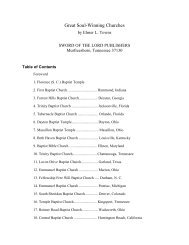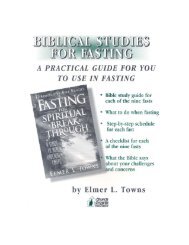PUTTING AN END TO WORSHIP WARS - Elmer Towns
PUTTING AN END TO WORSHIP WARS - Elmer Towns
PUTTING AN END TO WORSHIP WARS - Elmer Towns
- TAGS
- worship
- elmer
- towns
- elmertowns.com
You also want an ePaper? Increase the reach of your titles
YUMPU automatically turns print PDFs into web optimized ePapers that Google loves.
areas.<br />
4. Bridging - growth of the church by establishing churches indifferent cultural<br />
CHURCH EXTENSION<br />
Church growth through a strategy of planting new churches.<br />
CHURCH GROWTH<br />
The discipline that investigates the nature, function, health and death of Christian<br />
churches as they relate specifically to the effective implementation of God's Commission to<br />
"make disciples of all the nations" (Matt. 28:19). Church growth is simultaneously a theological<br />
conviction and an applied science, striving to combine the eternal principles of God's Word with<br />
the best insights of contemporary social and behavioral sciences, employing as its initial frame of<br />
reference the foundational work done by Donald McGavran and his colleagues.<br />
CHURCH GROWTH: SOCIAL SCIENCE<br />
In the past twenty years the Church Growth movement has grown into public recognition<br />
for several reasons. First, superchurches have emerged on the scene and become influential in<br />
determining and applying Church Growth strategy. Second, there is a growing interest in the<br />
science and practice of church planting. Third, there seems to be more exposure by media to<br />
growing churches in general than two decades ago. At the same time the Church Growth<br />
movement has become a discipline, and it has become more sophisticated as it uses both<br />
theological and sociological research to examine churches to determine principles of growth.<br />
Church Growth is a behavioral science. As such, it follows the scientific method of<br />
inquiry as do the other natural sciences, i.e., psychology, sociology, etc. the scientific method<br />
involves five steps. First, data must be gathered by the Church Growth researcher. This involves<br />
finding all of the facts about one source of church growth, or all the facts why there is no growth.<br />
Second, the data are examined for causes and effects. At this place the researcher determines if<br />
when the facts are repeated, they will bring about the same results in growth. If it does, it leads<br />
to the third step where the researcher suggests a hypotheses is found. This is a suggested<br />
principle or law that causes church growth. (The word hypotheses comes from hypo meaning "to<br />
propose" and theses meaning "an unproven law.") The fourth step is to test the suggested law to<br />
see if it is functional, workable and produces the same results in all situations. When the results<br />
are consistent, the fifth step leads to establishing the results as a law or principle that will<br />
produce evangelism and church growth, or when the law is broken, will cause a church to plateau<br />
or deteriorate.<br />
CLASSIFICATIONS OF REVIVAL<br />
The six major classifications of revival based on the apparent causal factors of that<br />
revival include (R-1) revivals which may be a response to the discovery, comprehension, and<br />
application of a particular doctrine, (R-2) revivals which may be led by a charismatic leader, (R-
















